It’s nearly summer, and in the UK that means that one out of every 4 weekends will be BBQ-friendly, if we’re lucky.
But if you’re in or near London and you want smoky goodness without having to cower under an umbrella, you should get to the Duke’s Head in Highgate for Prairie Fire BBQ’s June residency.
I got to sneak a peek behind the scenes into the cramped quarters of the Duke’s Head kitchen, where every month, guest chefs take over and share their skills.
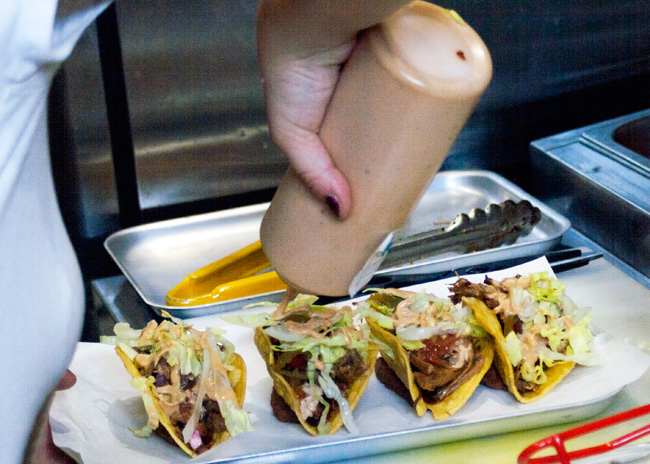
Prairie Fire is the brain child of American Michael Gratz, who saw a gap in the market for Kansas City style slow cooked meat. In the Duke’s Head kitchen, you’ll find his collaborators, Londoners Louis Lillywhite and Yasemin Ozekimci managing the meat, the veggie burgers, and all the fixins. Look to Laura’s homemade brownies, if you have any room left when you’re finished.
Speaking of, here’s what you’d find on the menu if (no … when) you make your way over.
Pulled pork tacos in freshly-fried shells, crunchy and absolutely loaded with toppings like chipotle sour cream, spring onions and punchy chiles. Don’t forget to try the refried bean ‘glue’ underneath, especially if you have any shell shards left over.
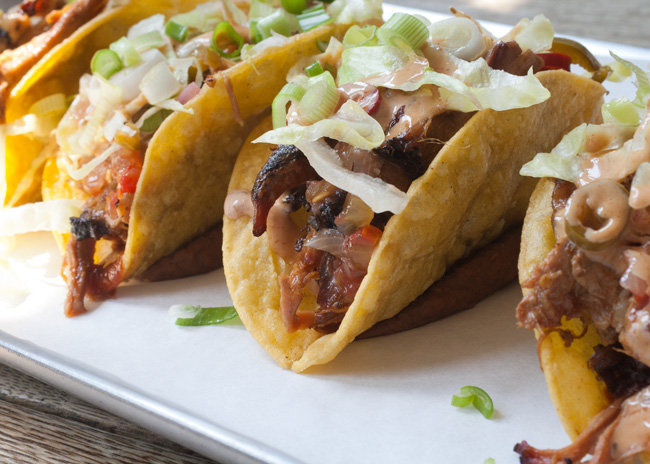
The mac & cheese is made with beautiful big curly tubes, al dente and covered in a silky, creamy unctious cheese sauce. I decided not to pry for the secret recipe, but this is a down and dirty cheese sauce, not some overwrought stilton and leek gastropub version.
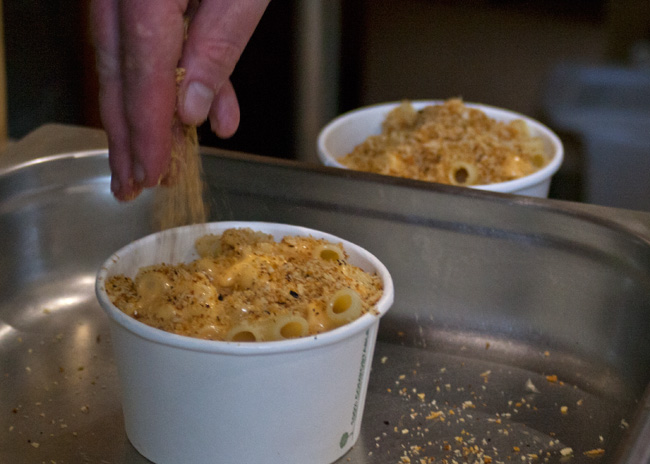
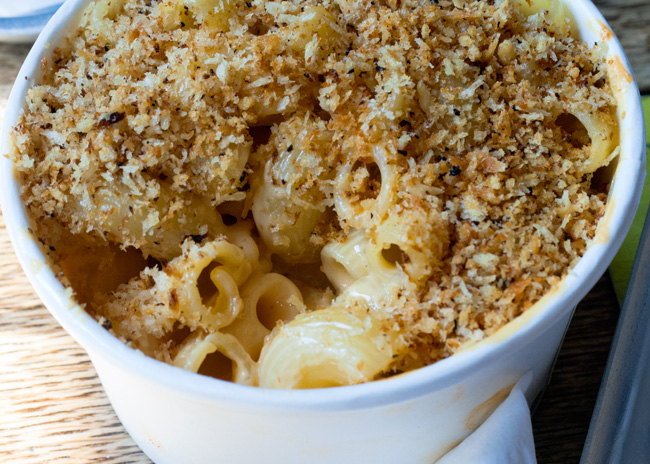
That PFQ burger. A brief moment of doubt crept in when I cut it in half and the patties weren’t as pink as I tend to have them. After taking a bite, I realized I was very wrong. Louis’s blend of chuck and rib tip beef was juicy, meaty … very messy and absolutely packed with flavor. All of that in a toasted bun with gooey melty cheese.
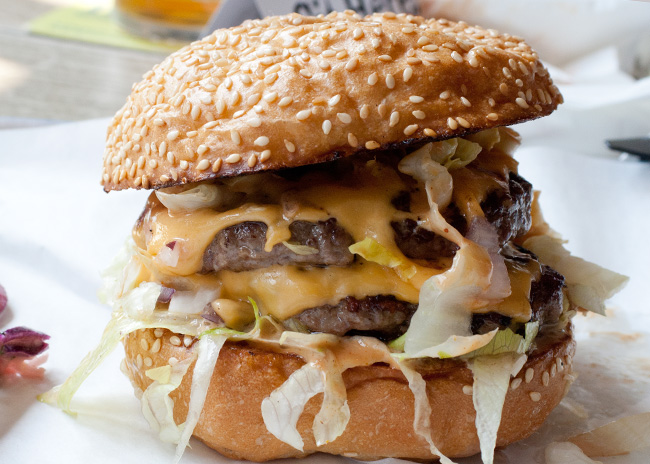
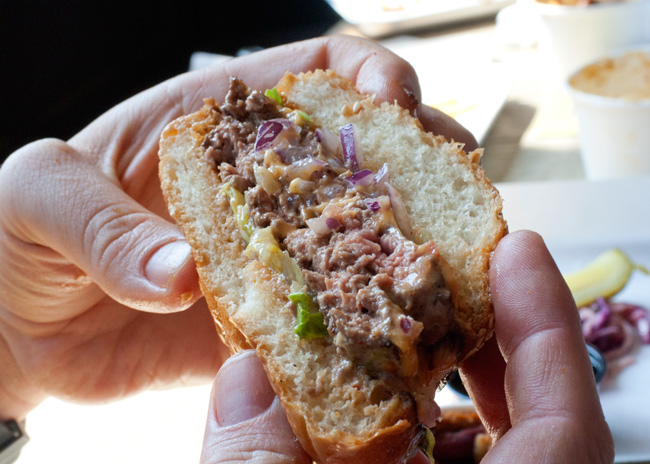
Fall-apart in your fingers 16-hour smoked brisket in a delicious floury but not dry or dense bun. Seriously, why is it so hard to find a good bun? These guys have gotten it absolutely right.
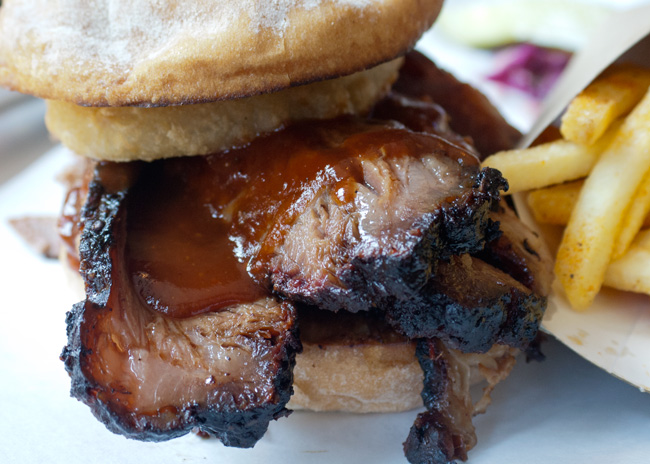
The brisket completely surrenders to a plastic knife. Useful, because I was sharing it. Compared to some recent City-based brisket that will remain unnamed, this was soft and tender, lightly seasoned and obviously given the low and slow treatment. And get a look at that Prairie Fire BBQ sauce…
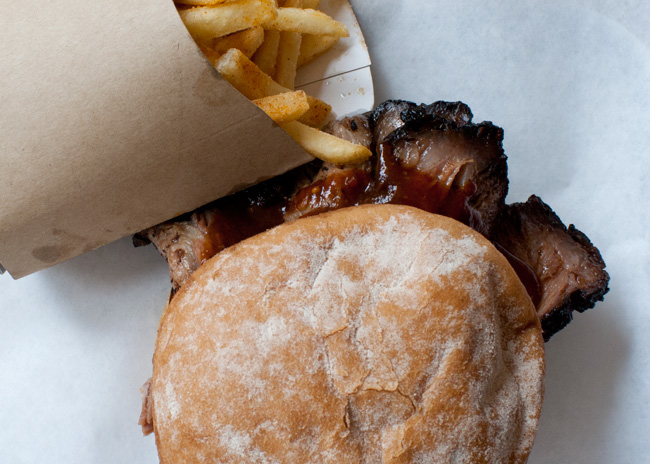
While it’s easy to ignore the fries as just another side dish, I can’t go without mentioning them. Crispy and crunchy, not even slightly oily, and generously dusted with spice that reminds me just a little bit of Old Bay (for the East Coasters). I barely had space for them but couldn’t stop picking at my portion, and maybe everyone else’s portions, too.
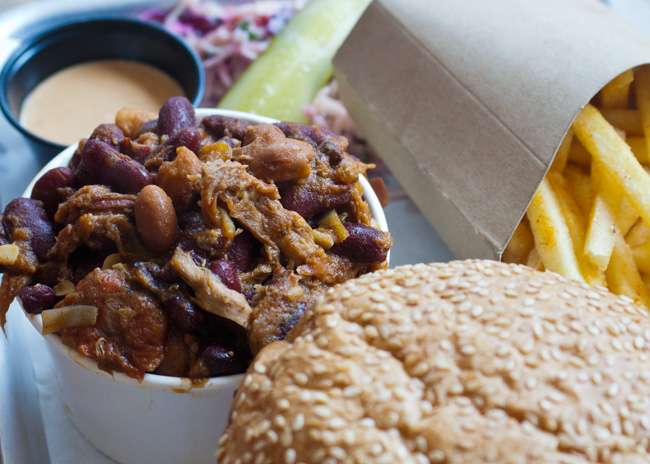
Like I said, there is also a veggie burger, but I can’t say that I’ve tried it. If you do, I’d be curious to know if you recommend it.
If you’re a beer drinker, I recommend spending a few indecisive minutes at the bar with the many great rotating options. There’s also a gin bar with Highgate-distilled Sacred and a temptation-filled cocktail menu.
While Prairie Fire don’t have anything else official in the calendar yet, keep an eye on the Prairie Fire BBQ Twitter for food market updates… and maybe even another residency soon.
Prairie Fire BBQ is at the Duke’s Head for the rest of June, every day of the week, and the kitchen is open from 12pm to 10pm.
Keep your eyes peeled for them at Brisket Fest, where I’ve been promised you can try something from Prairie Fire that no one in the UK has done before.
]]>I’m not the biggest American football fan (except… go Jets!). But I love Super Bowl parties. Because of the time difference, it’s a lot harder to justify hosting a party for a game that starts at 11pm (British time) on a Sunday. And it’s even worse when it’s hosted on the West Coast. Woe is me, I know.
Don’t worry about me, though. It is not going to stop me from feasting, especially since Super Bowl food is so good.
Im going to admit to enjoying some of the finer “junk” foods in life, including saucy wings and 7 layer dips. I’m also going to admit that I don’t have a deep fat fryer, and something about dumping that much oil into anything feels … expensive.
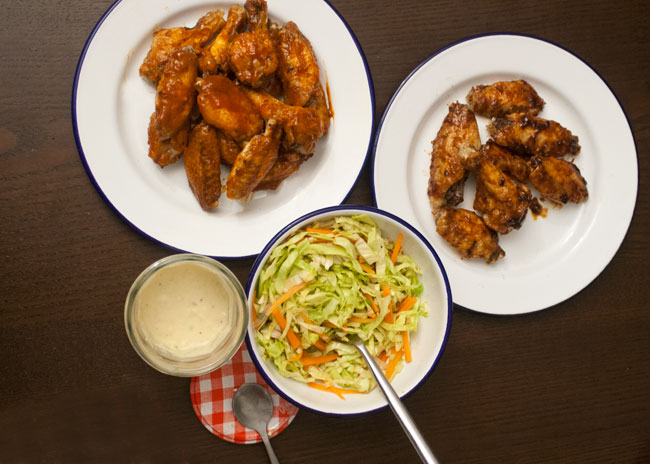
So here’s a recipe for those of you who want wings but don’t want a vat of sizzling oil hanging around. Or for anyone who wants to feel a little more saintly by telling everyone these are baked chicken wings, rather than fried.
I learned the tip that makes this recipe from one of my favorite food celebs, Alton Brown. It’s clever, it’s easy and it works. Steam your wing pieces to render out the fat, making for crispy oven-baked skin. Don’t worry, you won’t dry them out, because the steaming helps with that, too.
It’s worth noting that the steamed wings must sit in the fridge for at least an hour to cool off and dry.
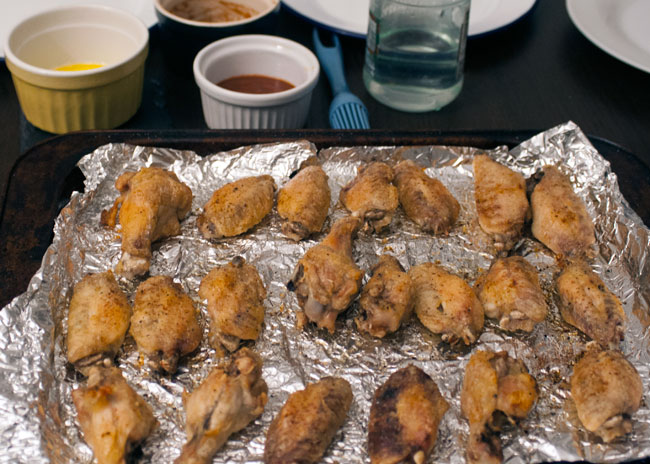
Crispy baked chicken wings will be yours before you know it.
Since I find it hard to make a decision, I make 2 different sauces to keep it interesting. You can go any direction you want. Sweet sticky barbecue, lip-tingling spice, deep and smoky…
Well … on to the recipe.
Technique based on Alton Brown’s buffalo wings.
5
Serves 4
30 minPrep Time
45 minCook Time
2 hr, 15 Total Time
On the Counter
- 10 chicken wings, or 20 wing pieces
- salt
- freshly ground black pepper
- 4 tbsp (about 50 g) butter
- 3 tbsp chipotle paste
- 2 tsp honey
- 1 tsp cider vinegar
- salt to taste
- 3 tbsp (50 mL) cayenne sauce, like Frank's RedHot (my personal choice)
- 1/4 tsp garlic powder
- 1 tsp cider vinegar
- salt to taste
What to Do
- If you're starting with full wings, segment them into 3 pieces, at the joints. You can save the wing tips for chicken stock, but you won't need them for this recipe.
- Set water boiling in a steamer pot. Once the water is at a boil, place the wing pieces, in one layer, in the steamer. Cover. Steam them for 10 minutes, turn them over, and steam them for another 5-10 minutes to render out the fat.
- Take pot off the heat, and carefully remove the wings. With paper towels, dry them and set them onto a cooling rack, sitting above a tray.
- Refrigerate the steamed wings for at least 1 hour.
- Meanwhile, make or prepare your wing sauce, or sauces.
- Heat the oven to 200 C (390 F).
- Cover a tray with foil, and lay out the wing pieces. Season them with salt and pepper.
- Set the tray on the oven's middle rack and bake the wings for 15 minutes, skin side up. Flip them and roast for another 10 minutes. They should be at least 74 C (165 F) internally and the skin should be golden.
- Meanwhile, melt the butter and put it in a small bowl or jar.
- Brush the chicken wings with butter, and then toss them in with the wings sauce or sauces.
- In a medium bowl for each sauce, combine all the ingredients. If the sauce needs to be thinned out, add some water, 1 teaspoon at a time and stir it together.
If you want a veggie-friendly Super Bowl snack, why not try vegetarian nachos instead?
]]>Recently, the gentleman and I were in Sweden for few days. It was my first trip that far north – which is a fact I checked on the map as I write this. (I’ve also just learned that most of Scotland is a lot further north than I realized.)

Besides the super-friendly people, the ease of watching ice hockey on TV (yep hockey fan here), and the interesting (but expensive) beer selection, my favorite part of Sweden was the food. Of course.
Oh, the food. Giant buffet breakfasts with 3 kinds of eggs, caviar in a tube, yogurt with seeds, cereal, nuts – you name it. Four kinds of bread, pastries…
But this is not a breakfast recipe. Because just about everything that I had on our four days in Sweden was excellent. Cinnamon buns at the cafe, chicken terrine, Swedish-style beef tartare and wild boar (a-may-zinng) for our Valentine’s Day dinner, pub dinners that included beef stew, lightly breaded fried fish and brisket…
Ok, I need to stop. Just know that Sweden = delicious.
In the interest of authenticity and a bit of tourism, we had to have try Swedish meatballs. Maybe the ones that were considered the best in town. Maybe we looked them up to check.
And then, maybe the weekend after, just in time for the Sweden/Canada Olympic Ice Hockey gold medal game, we made homemade Swedish meatballs. They got rave reviews from the hockey viewing party, who all happened to be rooting for the Swedish team. I think the meatballs helped heal our crushed spirits.

If you like comfort food that’s easy to make and store in the freezer – you should make these too.
To keep mostly authentic, I’d suggest serving them with mashed potatoes (mine included whole grain mustard because a. it’s delicious and b. there was a lot of mustard in Sweden) and lingonberry jam. Slightly less authentically, we may have also had some steamed spinach. It worked well.
Ikea sells a reasonably good and reasonably cheap jar of lingonsylt (lingonberry jam), and I personally think it’s also delicious stirred into oatmeal or on toast.

Makes about 35 meatballs, and they freeze well.
Serving size: 3-4 meatballs
On the Counter
2.2 pounds (1 kg) ground beef (or 50/50 beef-pork mixture)
2 medium onions, grated
1 tbsp olive oil + 1 tbsp olive oil
2 large eggs
4/5 cup (200 ml) milk
1 cup beef or chicken broth
100 g whole wheat breadcrumbs
1/2 tsp ground allspice
2 tsp soy sauce
2 tbsp creme fraiche or sour cream
1 tsp + 1 tsp salt
freshly ground black pepper
Serve with:
Mashed Potatoes
Lingonberry Jam
Spinach (optional, less traditional)
What to Do
Combine the milk and breadcrumbs and set aside for 15 minutes.
Meanwhile, sweat onions in 1 tbsp olive oil until soft, transfer to large bowl and allow to cool. Add beef and pork to onions, mix in eggs, milk and breadcrumbs, season with allspice, 1 tsp salt and several grinds of black pepper. Combine well and allow the mixture to rest for 10 minutes.
Form meat into balls (roughly one inch in diameter) by rolling them between your palms until they’re tightly packed. Set aside those that you plan to cook and see below for freezing suggestions.
Heat 1 tbsp olive oil in a large nonstick skillet over medium-high heat until shimmering. Add meatballs in a single layer and brown on all sides, about 5 minutes total. Set meatballs aside on a plate, and finish off all meatballs. Put them all back into the pot and add broth.
Cover the pot, and simmer over medium-low heat until the meatballs are cooked through, (with an internal temperature of 170 F or 76.5 C) about 10 minutes.
Add soy sauce and crème fraîche or sour cream. Stir carefully to just combine and simmer until the sauce begins to thicken. Season to taste with salt and pepper.
To freeze: Line up the remaining meatballs on a cookie sheet lined in plastic wrap. Cover them with more plastic wrap. Freeze them overnight, and transfer them into a zip top bag. They should be fine in the freeze for 3-4 months, and probably longer.
]]>Does 2 years make something a tradition? I’m going to say it does. This year, the gentleman and I continued our tradition of having another couple over for a joint-effort Easter meal. We tend to eat and drink a fair amount, in the most relaxing and comfortable way.
This year we took a break for the Oxford/Cambridge Boat Race, which was happening about 10 minutes away, by the River Thames. I’m still surprised they held it on Easter Sunday, but I guess they have a tradition to uphold, too. We probably could have gotten there earlier, but settled for seeing the boats start and nearly-seeing the big screen.
Our Sunday meal (a lunch-dinner-late night snack hybrid of all day eating) was so much fun to make, and even more fun to eat. It was a combined effort from all 4 of us, as I think the best shared meals are.
We started with pesto palmiers…


and parmesan and roasted garlic ones, too.

Plus, my favorite starter, herbed crepes with creme fraiche, cucumber and salmon.

And then, of course, the roasted lamb…


And for dessert: Meringues filled with lemon posset, home-whipped cream and fresh berries. A preview of spring on a plate.

And finally… the late night snack. Caramel peanut butter popcorn.

Oh, but how could I forget? Spike the Belgian Chocolate Hedgehog.

I had some amazing souvlaki in Santorini, on a tiny island called Thirasia. There were more cats than people living on the island, and it was a very interesting, and slightly surreal place to visit for a few hours. Our tour guide recommended a restaurant on the beach; it was a place that she said she went to every time she was there. (Which, I’m guessing, was probably once a day.)
It was absolutely delicious, and half of the seating was on a deck sitting above the ocean. It was a peaceful and amazing meal, accompanied with a very refreshing Greek beer. I’m sure it all tasted even better after my companion and I hiked up a mountain of stairs to see the village, but that doesn’t take away from it being so, so good.

However, of the list of tasty things that we had while in Santorini, it wasn’t one of the first things that I recreated after returning. I’ve had a healthy stock of Greek yogurt in the fridge since, and I have a newfound love for speciality honey. Souvlaki came to mind again when I was uploading photos from the trip. There it was, that beauty of a dish, waiting for me perpetually in a photo.

Traditionally, souvlaki is pork. I was surprised to learn it, as I thought for sure it would have been lamb. I was pretty insistent on having it in the most traditional way possible, so pork on a small, barely-populated island had to be the way to go.
Mine wasn’t nearly as good as the amazing souvlaki I had looking out at the islands of Santorini, but it’s a pretty tasty second-runner. It’s recommended to marinade your pork overnight, so it’s not going to be a meal I could put together on the fly, unfortunately.
In the making of my souvlaki, I went a slightly untraditional route. Because I was just cooking for myself, I didn’t bother with the skewers, and I decided to eat it more like a sandwich than a fork-and-knife meal. Really, the whole thing was pretty untraditional, since I also broiled (grilled) it rather than putting it on the grill (BBQ). As an aside, talk about confusing terms. Broil (US) = Grill (UK); Grill (US) = BBQ (UK). Some of the differences still take a bit of getting used to.
But now, on to the recipe!
On the Counter:
Serves: 4
for the tzatziki:
(I like mine strong; add more yogurt if you like it less intense)
8 oz (225g) fat free Greek yogurt (I use Fage, or Chobani in the states)
1/2 cucumber
the juice of half a lemon
1 clove garlic
salt
for the pork:
1 lb pork loin or tenderloin
1/4 cup red wine
1/4 cup olive oil
3 cloves garlic, minced
2 tsp dried thyme
1/4 tsp salt
1/4 tsp pepper
for the plate:
4 whole wheat pitas
2 vine-ripened tomatoes
1/2 onion (preferably red)
1 handful lettuce/salad greens per person
1 vine-ripened tomato
What to Do:
for the tzatziki:
You can also make this ahead.
Peel and de-seed cucumber, then grate it into a bowl. Sprinkle the cucumber with salt, let sit for 5 minutes. Wrap it in a paper towel and squeeze out excess water. Put it back into the bowl.
Finely mince garlic, add to bowl.
Squeeze lemon juice into bowl.
Add yogurt and stir well to combine.
for the pork:
In a large, non-metal bowl, whisk together wine, garlic, oil, thyme, salt and pepper.
Cut pork into one inch cubes.
Add pork to marinade, stir to coat. Cover bowl and refrigerate for up to 24 hours.
If using wooden skewers, soak in water for 30 mins before using.
Grill/BBQ: Heat grill to medium-high for 10 mins, turning occasionally until cooked.
Oven: Broil/grill on medium heat, about 6 inches away from the heat, for 6 minutes, turning the skewers once halfway through.
The pork should show just the slightest bit of pink in the center.
for the plate:
Slice tomatoes into wedges, seed if desired, then cut wedges in half.
Thinly slice red onion.
Slice pitas in half and gently open up the pockets.
Place all veggies and pita onto the plate in the arrangement of your choice. Add a dollop of tzatziki and the pork, and serve.
I love being inspired by dishes while traveling. Next, I’m hoping to try my hand at baked feta. Have you ever been inspired by meals you’ve had while traveling?
]]>
There are times when walking into the supermarket with no plan is a disaster. Other times it’s an inspiration. Thankfully, this recipe transpired from an inspirational trip.
I was wandering through the meat department, as I do, and spotted a beautiful set of lamb steaks. And then I spotted the lovely sticker on the package. 2 for £7. Armed with my 2 lamb steaks and a nice pair of beef rump steaks (to use in a later post), I was ready to go.
There was also a bag of fresh peas languishing in the fridge, which offered the perfect opportunity for… pan-seared lamb steaks and minted mushy peas.
Even though I’ve lived in London for 1.5 years, I haven’t spent much of that time cooking British food. It’s been too tempting to take advantage of all the continental European ingredients – the Italian cheese, French cream and Greek olives. After this success, though, I might have to rethink that stance.
A nice piece of tender lamb (not mutton) is quick to cook (and just as quick to ruin). I pan-seared this, but it would be just as lovely on the grill. You could also make this a pea puree, rather than mushy peas. To do that, just replace the mushing with food processing.

Serves: 4
On the Counter:
the lamb:
4 lamb steaks
6 sprigs-worth of fresh thyme, leaves only
kosher or ground rock salt
1 tsp olive oil for marinade
2 tsp olive oil for pan
the peas:
3 cups (400 g) fresh or frozen peas
4 springs fresh mint
4 tablespoons melted butter
What to Do:
Chop thyme leaves and combine them with a few grinds of salt and olive oil. Mash them up with a mortar and pestle. Rub or brush onto both sides of your lamb steaks. Let them sit for at least 30 minutes. (Don’t skip the marinading – it’s worth it!)
Boil the peas in lightly salted water until tender (about 3 minutes). If using frozen, heat them according to the package directions. Chop mint finely. Once the peas are finished, drain them and combine butter, mint and a pinch of salt. Mash them up with a mortal and pestle, until they are mushy to your taste.
Drizzle olive oil onto a griddle or flat-bottomed frying pan. Heat (on medium-high) until the oil shimmers. Flick a few drops of water onto the skillet to test; if they dance and sizzle, it’s ready. Place your lamb steaks onto the pan and press them down. Don’t crowd the pan; make sure each one has some space. For medium rare, cook them for 4 minutes on each side. Medium: 5 minutes, then 4 minutes. This obviously depends on the thickness of your pieces. Mine were about 3/4 inch thick (2 cm).
As soon as the timer goes off, take them off the heat and let them rest for 2 or 3 minutes on a plate.
On a warm plate, serve peas and lamb. This is also lovely with some french fries or a salad, but I’ll leave that to you!
I had a lot of fun taking photos of this one, so here are two extras that I just had to share. Check out that beautiful piece of lamb!
 |
 |
 Save Recipe
Save Recipe
